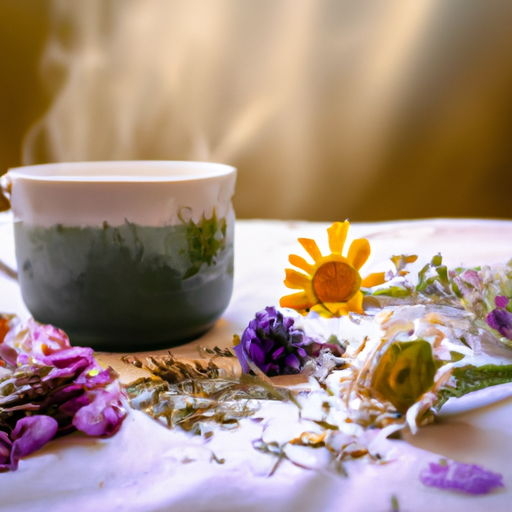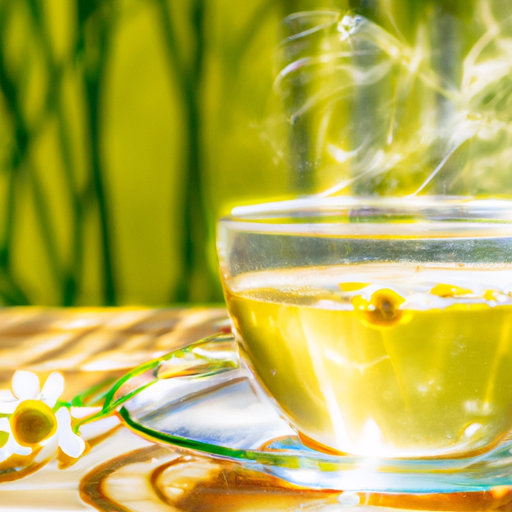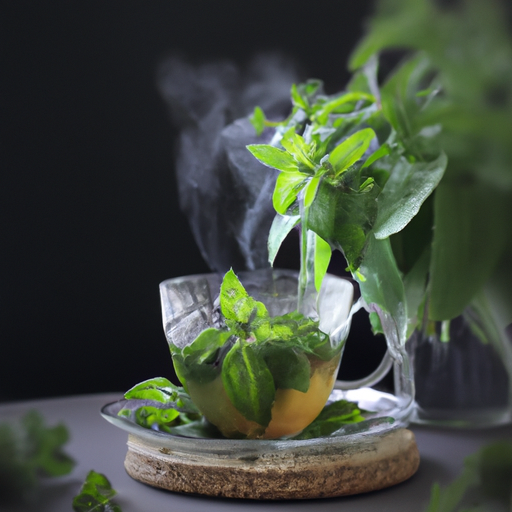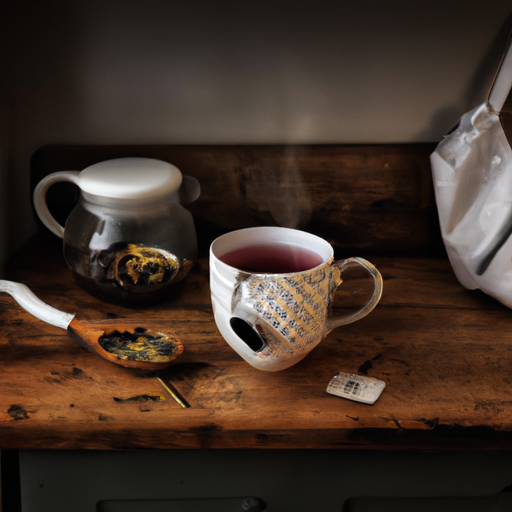Are you curious about whether there is a natural solution to calm and heal your dermatitis? You’re in luck! This article will explain how to create an herbal tea that is tailored to provide relief for dermatitis. By utilizing the therapeutic benefits of handpicked herbs, this tea can aid in easing the distressing symptoms linked to this skin condition.
From choosing the right herbs to applying the tea topically and drinking it for internal healing, I will provide you with detailed instructions to ensure maximum efficacy. Dermatitis can be a persistent and bothersome condition, but with the right herbal tea, you can take control of your skin’s health and well-being.
So, let’s dive in and discover how to make this soothing and rejuvenating herbal tea for dermatitis relief!
Key Takeaways
- Chamomile, calendula, lavender, and marshmallow root are beneficial herbs for dermatitis relief.
- Boil water and add herbal mixture for tea infusion.
- Steep tea for 10-15 minutes to release healing compounds.
- Apply tea topically using a clean cloth or cotton pad, gently patting it onto affected areas for maximum absorption.
Choose the Right Herbs for Dermatitis Relief
Now, it’s time for you to choose the herbs that’ll bring you soothing relief from your dermatitis. Choosing herbal remedies for dermatitis is a natural and effective way to alleviate symptoms and promote healing.
There are various herbs that’ve been traditionally used for their anti-inflammatory and calming properties. Chamomile is one such herb known for its ability to reduce redness and itchiness. Calendula is another great option, as it helps to soothe irritated skin and promote healing. Lavender is also widely used for its calming properties and can help reduce inflammation.
If you prefer a stronger anti-inflammatory effect, you can try adding a pinch of turmeric to your herbal tea. These herbal tea alternatives provide a gentle and holistic approach to relieving dermatitis symptoms.
Now, let’s move on to gathering the ingredients for your herbal tea.
Gather the Ingredients
First, gather all the necessary ingredients for your soothing skin remedy. When making a herbal tea for dermatitis relief, it’s important to use organic ingredients to ensure their purity and effectiveness.
There are several herbs that have been found to be beneficial for dermatitis, including chamomile, calendula, lavender, and marshmallow root. You can try different combinations of these herbs to find the blend that works best for you.
Chamomile and calendula are known for their anti-inflammatory properties, while lavender has soothing effects on the skin. Marshmallow root helps to moisturize and soothe dry, itchy skin.
Once you’ve gathered these ingredients, you can proceed to the next step of preparing your tea infusion.
Prepare Your Tea Infusion
To prepare your soothing skin remedy, start by gathering all the necessary organic ingredients, such as chamomile, calendula, lavender, and marshmallow root, known for their beneficial effects on dermatitis. Using different herbal combinations can enhance the tea’s healing properties.
To make the tea infusion, begin by boiling water in a pot. Once the water reaches a rolling boil, remove it from the heat and add a tablespoon of the herbal mixture. Cover the pot and let it steep for 10-15 minutes to allow the herbs to release their healing compounds.
While steeping the tea properly, take a moment to inhale the calming aroma that fills the room. This simple act can help relax both your mind and body.
After the steeping time is over, strain the tea using a fine mesh strainer.
Now that the tea infusion is ready, let the tea cool down before applying it to your skin. Transitioning into the subsequent section, allowing the tea to cool will ensure a soothing and refreshing experience for your irritated skin.
Let the Tea Cool Down
As the tea infusion cools, your irritated skin will be refreshed and soothed, like a cool breeze on a hot summer day. Allowing the tea to cool down is an essential step in maximizing the benefits of drinking herbal tea daily for dermatitis relief. By giving the tea time to cool, it allows the active compounds in the herbs to fully infuse into the water, ensuring a potent and effective brew. Additionally, cooling the tea allows it to air dry naturally, which further enhances its healing properties. This process allows the tea to retain its medicinal properties and ensures that it is at the optimal temperature for application. Once the tea has cooled down, we can move on to the next step of applying the tea topically to your irritated skin.
Apply the Tea Topically
To apply the tea topically, I use a clean cloth or cotton pad to gently pat the tea onto my affected areas. I make sure to cover all the necessary spots and apply just enough pressure to ensure the tea is absorbed into the skin.
After applying, I allow the tea to air dry completely before continuing with my skincare routine.
Using a clean cloth or cotton pad to apply the tea to affected areas
First, grab a soft cloth or a cotton pad and dip it into the herbal tea mixture. This step is crucial for applying the tea topically and soothing skin irritation caused by dermatitis. Here’s a list of four key points to keep in mind when using a cloth or cotton pad to apply the tea:
-
Gently squeeze out any excess liquid from the cloth or pad to avoid dripping.
-
Start by applying the tea to the affected areas, gently pressing and holding the cloth or pad against the skin.
-
Move in small, circular motions to ensure even distribution of the tea.
-
Continue to apply the tea until the affected areas are fully covered and the skin feels well-moisturized.
By following these steps, you can effectively deliver the healing properties of the herbal tea to your skin. After applying the tea, we can now move on to gently patting it onto the skin for maximum absorption and relief.
Gently patting the tea onto the skin
After applying the tea, gently pat it onto the skin to promote maximum absorption and provide soothing relief. Applying tea with a gentle touch is crucial to avoid further aggravating the irritated areas. By using a clean cloth or cotton pad, the tea can be evenly distributed and absorbed into the skin. Gently patting the tea onto the affected areas ensures that the soothing properties of the herbal tea are directly delivered to the dermatitis-prone skin. This gentle action also helps to calm inflammation and reduce itching. The table below summarizes the benefits of applying tea with a gentle touch and soothing the skin with herbal tea:
| Applying Tea with a Gentle Touch | Soothing the Skin with Herbal Tea |
|---|---|
| Promotes maximum absorption | Provides soothing relief |
| Prevents further irritation | Calms inflammation |
| Reduces itching |
By employing these techniques, the herbal tea can effectively alleviate the symptoms of dermatitis. Moving forward, allowing the tea to air dry will further enhance its therapeutic effects.
Allowing the tea to air dry
Once the tea has been gently patted onto the skin, it’s time to let it air dry and work its magic. Air drying is a crucial step in the herbal tea treatment for dermatitis as it allows the beneficial properties of the herbs to penetrate the skin and provide relief. Here are three key benefits of air drying the tea:
-
Absorption: Allowing the tea to air dry ensures that the skin absorbs the herbal infusion thoroughly, maximizing its healing potential.
-
Soothing Effect: The natural ingredients in the tea, such as chamomile or calendula, have calming properties that can soothe irritated skin. Air drying enhances this effect by giving the skin time to absorb the soothing compounds.
-
Convenience: Air drying is a simple and convenient method of application. It requires no additional tools or steps, making it an accessible option for anyone seeking relief from dermatitis.
As the tea dries, you may start feeling a soothing sensation on your skin. This indicates that the herbal infusion is beginning to work its magic. Next, we’ll explore how drinking the tea can promote internal healing.
Drink the Tea for Internal Healing
I love starting my day with a cup of herbal tea because not only does it taste great, but it also provides numerous health benefits.
One of the key reasons I enjoy drinking herbal tea is because of its anti-inflammatory properties, which can help reduce inflammation internally and promote healing from within.
Additionally, herbal tea is a great way to stay hydrated and support overall skin health, as it provides a gentle and nourishing source of hydration for the body.
Enjoying a cup of herbal tea daily
To truly savor the soothing benefits of your herbal tea, indulge in a daily cup that’ll transport you to a peaceful oasis for your skin.
Drinking herbal tea on a regular basis promotes relaxation and boosts your immune system, which are both crucial for managing dermatitis. As you take a sip, feel the warmth of the tea enveloping your senses, bringing with it a sense of calm and tranquility.
The carefully selected herbs in your tea blend work their magic, reducing inflammation and irritation from within. By incorporating this daily ritual into your routine, you’re not only benefiting from the anti-inflammatory properties internally, but also creating a moment of self-care and rejuvenation for your skin.
So sit back, relax, and let your herbal tea be your skin’s best friend.
Benefiting from the anti-inflammatory properties internally
Indulge in the daily ritual of enjoying a cup of herbal tea and let its anti-inflammatory properties work their magic on your skin from within.
Herbal teas have long been known for their medicinal benefits, and when it comes to dermatitis, they can be particularly helpful. Not only do they have a soothing effect on the skin, but they also offer internal benefits that can aid in managing dermatitis symptoms.
Herbal teas, such as chamomile and green tea, are rich in antioxidants and have natural anti-inflammatory properties that can reduce redness and irritation. Moreover, incorporating herbal tea into your daily routine can promote healthy digestion, which is essential for maintaining clear and radiant skin.
So, sip on a cup of herbal tea daily and let it nourish your body from the inside out, preparing your skin for the next step: hydrating the body and promoting overall skin health.
Hydrating the body and promoting overall skin health
Quench your skin’s thirst and enhance its overall health by ensuring that your body stays well-hydrated. Hydration is essential for maintaining healthy skin, especially for those with dermatitis. Drinking an adequate amount of water throughout the day helps to flush out toxins, promote cell regeneration, and maintain the skin’s elasticity.
Additionally, incorporating herbal teas into your skincare routine can provide further hydration and nourishment. Chamomile, calendula, and green tea are known for their hydrating properties and can help soothe inflamed skin. You can either drink these teas or use them topically as a facial mist or compress.
Remember, consistency is key in achieving optimal results. By adopting a regular hydration routine and incorporating herbal remedies, you can promote overall skin health and alleviate the symptoms of dermatitis.
Consistency is Key
Maintaining a consistent routine of herbal tea consumption is crucial for effectively managing dermatitis symptoms. Consistency is key when it comes to reaping the benefits of regular use. By incorporating herbal tea into your daily routine, you can promote overall skin health and hydration, which is essential for managing dermatitis.
Consistency tips include setting a specific time each day to enjoy your herbal tea, whether it’s in the morning, afternoon, or evening. This helps create a habit and ensures you don’t miss a day. Additionally, keeping herbal tea readily available and easily accessible can help you stay consistent.
Whether you prefer chamomile, green tea, or calendula, regular consumption of herbal tea can provide soothing relief and nourishment to your skin, helping to alleviate dermatitis symptoms over time.
Frequently Asked Questions
Can herbal tea cure dermatitis completely?
Herbal tea can provide relief for dermatitis symptoms, but it may not completely cure the condition. However, studies show that the benefits of herbal tea, combined with natural remedies, can help manage dermatitis effectively.
Are there any side effects of using herbal tea for dermatitis?
There can be potential interactions between herbal tea and medication for dermatitis. It is important to consult with a healthcare professional before using herbal tea as a treatment. Additionally, the effectiveness of herbal tea compared to other topical treatments may vary.
Can I use any type of tea leaves for making herbal tea for dermatitis?
Yes, you can use different tea blends to make herbal tea for dermatitis. Herbal teas like chamomile, green tea, and calendula have various benefits for the skin, soothing inflammation and promoting healing.
How long should I let the tea cool down before applying it topically?
I recommend letting the herbal tea cool down completely before applying it topically. This ensures that the temperature is safe for your skin and reduces the risk of burns or discomfort during application.
Is it necessary to drink the herbal tea for internal healing in addition to applying it topically?
Yes, it is necessary to drink the herbal tea for internal healing in addition to applying it topically. The internal consumption allows the healing properties of the tea to work from within, complementing the topical application for more effective results.
Conclusion
In conclusion, making a herbal tea for dermatitis is like creating a soothing oasis for your skin. By carefully selecting the right herbs and infusing them into a warm tea, you can provide relief and healing from within.
Just imagine the gentle touch of the tea, like a cool breeze on a hot summer day, calming your irritated skin. So remember, consistency is key. Incorporate this herbal tea into your daily routine and watch as your dermatitis becomes a distant memory.










